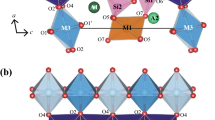Abstract
A series of 21 cordierites with 0.06<Fe2+ cations pfu <1.54 from different petrogenetic environments were studied by polarized electronic absorption single-crystal spectroscopy and 57Fe Mössbauer spectroscopy (MS). The electronic spectra measured in the range 35,000–1,000 cm–1 using microscope techniques were also obtained at different temperatures between 80 and 700 K on five different samples. The aim of this study was to answer the still-debated question of the location of iron in the cordierite structure. Both electronic absorption and 57Fe Mössbauer spectra confirm the presence of Fe2+ on two different structural positions. The major fraction, 90–99% of the total Fe2+, occupies the octahedral site 8g in orthorhombic cordierite. Minor amounts of Fe2+ occur in a second, non-octahedral site. The octahedral and non-octahedral Fe2+ give rise to two MS doublets and to different absorption bands in the electronic absorption spectra, namely ν1 and ν2 at about 8,300 and 10,000 cm–1 both of which are α-polarized for octahedral Fe2+, and β/γ-polarized ν3 at about 10,500 cm–1 for non-octahedral Fe2+. The integral intensities of the ν1 and ν2 bands increase linearly with increasing total iron contents. Their energies decrease slightly with increasing Fe2+. Increasing temperature causes a shift of ν1 to lower energies, while the integral intensities of ν1 and ν2 increase. These observations permit an assignment of the ν1 and ν2 bands to transitions derived from the 5T2g→5Eg transition of octahedral Fe2+. The integral intensity of the β- and γ-polarized ν3 band correlates linearly with the concentration of non-octahedral Fe2+. Its high molar extinction coefficient, ca. 150 cm–2 l mol–1, and temperature independence are best explained by its assignment to dd transitions of Fe2+ in tetrahedral coordination. There occurs also a broad band at 18,000 cm–1 polarized predominantly along b. Its properties are typical of a metal–metal charge transfer (CT) band involving Fe2+ on the octahedra and Fe3+ on the T11-tetrahedra, the two of which are edge-shared. All spectroscopic data, including changes in the electronic spectra caused by heating at 1,000° C in air, as well as crystal-chemical considerations, suggest that the ring-connecting T11-tetrahedra contain small amounts of Fe2+.
Similar content being viewed by others
Author information
Authors and Affiliations
Additional information
Electronic Publication
Rights and permissions
About this article
Cite this article
Khomenko, V.M., Langer, K. & Geiger, C.A. Structural locations of the iron ions in cordierite: a spectroscopic study. Contrib Mineral Petrol 141, 381–396 (2001). https://doi.org/10.1007/s004100100234
Received:
Accepted:
Published:
Issue Date:
DOI: https://doi.org/10.1007/s004100100234




